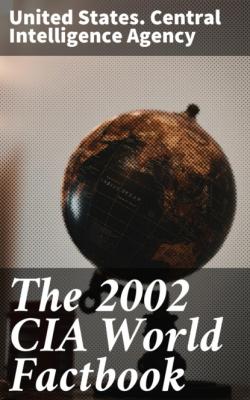ТОП просматриваемых книг сайта:
The 2002 CIA World Factbook. United States. Central Intelligence Agency
Читать онлайн.Название The 2002 CIA World Factbook
Год выпуска 0
isbn 4064066092382
Автор произведения United States. Central Intelligence Agency
Жанр Социология
Издательство Bookwire
[Artur BAGDASARIAN, chairman]; National Accord Front [Ashot MANUTCHARIAN];
National Democratic Alliance [Arshak ZADOYAN]; National Democratic Party
[Shavarsh KOCHARIAN]; National Democratic Union or NDU [Vazgen MANUKIAN];
Pan-Armenian National Movement or PANM [Alex ARZOUMANYAN]; People's
Democratic Party [Gagik ASLANYAN]; People's Deputies Group [Hovhannes
HOVHANISSIAN]; People's Party of Armenia [Stepan DEMIRCHYAN]; Republic
Party [Aram SARGSIAN]; Republican Party or RPA [Andranik MARKARYAN];
Shamiram Women's Movement or SWM [Shogher MATEVOSIAN]; Social Democratic
(Hunchak) Party [Yeghia SHAMSHAYN]; Social Democratic Union (formerly
National Self-Determination Union) [Paruyr HAYRIKIAN]; Twenty-first
Century Party [David SHAKHNAZARIAN]; Unity Bloc [Stepan DEMIRCHIAN and
Andranik MARKARYAN] (a coalition of the Republican Party and People's
Party of Armenia); Yerkrapah Union [Manval GRIGORYAN]
Political pressure groups and leaders: NA
International organization participation: BSEC, CCC, CE, CIS, EAPC,
EBRD, ECE, ESCAP, FAO, IAEA, IBRD, ICAO, ICRM, IDA, IFAD, IFC, IFRCS,
ILO, IMF, Interpol, IOC, IOM, ISO, ITU, NAM (observer), OAS (observer),
OPCW, OSCE, PFP, UN, UNCTAD, UNESCO, UNIDO, UPU, WFTU, WHO, WIPO, WMO,
WToO, WTrO (observer)
Diplomatic representation in the US: chief of mission: Ambassador Arman KIRAKOSIAN consulate(s) general: Los [1] (202) 319-1976 chancery: Diplomatic representation from the US: chief of mission: Ambassador John M. ORDWAY embassy: 18 Baghramyan Ave., Yerevan 375019 mailing address: American Embassy Yerevan, Department of [374](1) 521-611, 543-900 FAX: Flag description: three equal horizontal bands of red (top), blue, and orange
Economy Armenia
Economy - overview: Under the old Soviet central planning system, Armenia had developed a modern industrial sector, supplying machine tools, textiles, and other manufactured goods to sister republics in exchange for raw materials and energy. Since the implosion of the USSR in December 1991, Armenia has switched to small-scale agriculture away from the large agroindustrial complexes of the Soviet era. The agricultural sector has long-term needs for more investment and updated technology. The privatization of industry has been at a slower pace, but has been given renewed emphasis by the current administration. Armenia is a food importer, and its mineral deposits (gold, bauxite) are small. The ongoing conflict with Azerbaijan over the ethnic Armenian-dominated region of Nagorno-Karabakh and the breakup of the centrally directed economic system of the former Soviet Union contributed to a severe economic decline in the early 1990s. By 1994, however, the Armenian Government had launched an ambitious IMF-sponsored economic program that has resulted in positive growth rates in 1995-2001. Armenia also managed to slash inflation and to privatize most small- and medium-sized enterprises. The chronic energy shortages Armenia suffered in recent years have been largely offset by the energy supplied by one of its nuclear power plants at Metsamor. Armenia's severe trade imbalance has been offset somewhat by international aid, domestic restructuring of the economy, and foreign direct investment.
GDP: purchasing power parity - $11.2 billion (2001 est.)
GDP - real growth rate: 9.6% (2001 est.)
GDP - per capita: purchasing power parity - $3,350 (2001 est.)
GDP - composition by sector: agriculture: 29% industry: 32% services: 39% (2000 est.)
Population below poverty line: 55% (2001 est.)
Household income or consumption by percentage share: lowest 10%: 2.3% highest 10%: 35.2% (1996)
Distribution of family income - Gini index: 44.4 (1996)
Inflation rate (consumer prices): 3.1% (2000 est.)
Labor force: 1.4 million (2001)
Labor force - by occupation: agriculture 44%, services 14%, industry 42% (2000 est.)
Unemployment rate: 20% note: official rate is 10.9% for 2000 (2001 est.)
Budget: revenues: $358 million expenditures: $458 million, including capital expenditures of $NA (2001 est.)
Industries: metal-cutting machine tools, forging-pressing machines, electric motors, tires, knitted wear, hosiery, shoes, silk fabric, chemicals, trucks, instruments, microelectronics, gem cutting, jewelry manufacturing, software development, food processing, brandy
Industrial production growth rate: 3.8% (2001)
Electricity - production: 5.69 billion kWh (2000)
Electricity - production by source: fossil fuel: 36.34% other: 0% (2000) nuclear: 32.34% hydro: 31.32%
Electricity - consumption: 4.89 billion kWh (2000)
Electricity - exports: 704 million kWh note: exports an unknown quantity to Georgia; includes exports to Nagorno-Karabakh region in Azerbaijan (2000)
Electricity - imports: 300 million kWh note: imports an unknown quantity from Iran (2000)
Agriculture - products: fruit (especially grapes), vegetables; livestock
Exports: $338.5 million (f.o.b., 2001 est.)
Exports - commodities: diamonds, scrap metal, machinery and equipment, brandy, copper ore
Exports - partners: Belgium 23%, Russia 15%, US 13%, Iran 10% (2000)
Imports: $868.6 million (f.o.b., 2001 est.)
Imports - commodities: natural gas, petroleum, tobacco products, foodstuffs, diamonds
Imports - partners: Russia 15%, US 12%, Belgium 10%, Iran 9% (2000)
Debt - external: $839 million (June 2001)
Economic aid - recipient: $245.5 million (1995)
Currency: dram (AMD)
Currency code: AMD
Exchange rates: drams per US dollar - 564.08 (January 2002), 555.08 (2001), 539.53 (2000), 535.06 (1999), 504.92 (1998), 490.85 (1997)
Fiscal year: calendar year
Communications Armenia
Telephones - main lines in use: 568,000 (1997)
Telephones - mobile cellular: 25,000 (2001)
Telephone system: general assessment: system inadequate; now 90% privately owned and undergoing modernization and expansion domestic: the majority of subscribers and the most modern equipment are in Yerevan (this includes paging and mobile cellular service) international: Yerevan is connected to the Trans-Asia-Europe fiber-optic cable through Iran; additional international service is available by microwave radio relay and landline connections to the other countries of the Commonwealth of Independent States and through the Moscow international switch and by satellite to the rest of the world; satellite earth stations - 1 Intelsat (2000)
Radio broadcast stations: AM 9, FM 6, shortwave 1 (1998)
Radios: 850,000 (1997)
Television broadcast stations: 3 (plus an unknown number of repeaters) (1998)
Televisions: 825,000 (1997)
Internet country code: .am
Internet Service Providers (ISPs): 9 (2001)
Internet users: 30,000 (2001)
Transportation Armenia
Railways: total: 852 km in common carrier service; does not include industrial lines broad gauge: 852 km 1.520-m gauge (779 km electrified) (2001 est.)
Highways: total: 11,300 km paved: 10,500 km (includes some all-weather gravel-surfaced roads)

